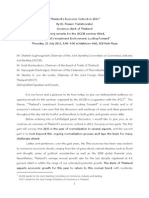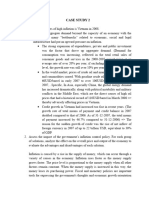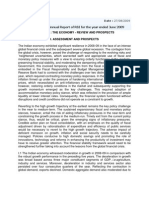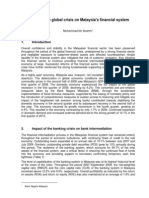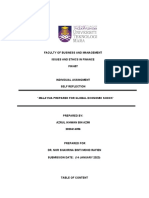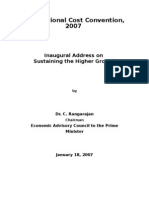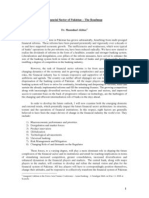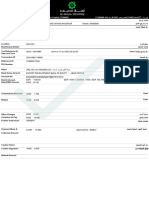Zeti Akhtar Aziz: The Next Wave For The Financial System in Malaysia
Zeti Akhtar Aziz: The Next Wave For The Financial System in Malaysia
Uploaded by
ormanscribdCopyright:
Available Formats
Zeti Akhtar Aziz: The Next Wave For The Financial System in Malaysia
Zeti Akhtar Aziz: The Next Wave For The Financial System in Malaysia
Uploaded by
ormanscribdOriginal Title
Copyright
Available Formats
Share this document
Did you find this document useful?
Is this content inappropriate?
Copyright:
Available Formats
Zeti Akhtar Aziz: The Next Wave For The Financial System in Malaysia
Zeti Akhtar Aziz: The Next Wave For The Financial System in Malaysia
Uploaded by
ormanscribdCopyright:
Available Formats
Zeti Akhtar Aziz: The next wave for the financial system in Malaysia
Keynote address by Dr Zeti Akhtar Aziz, Governor of the Central Bank of Malaysia, at the
12th Malaysian Banking Summit organised by ASLI "Taking the Leap in Paradigm Shift of
Banking – New Wave, New Ventures", Kuala Lumpur, 5 June 2008.
* * *
In this recent decade we have seen a period of profound modernisation of the Malaysian
banking sector. Today, the banking sector has evolved from facilitating and supporting the
economic growth process to becoming a significant source of growth. Innovation and product
pioneering has proliferated the diversity of products and services offered. The adoption of
best business practices, the use of new technologies, systematic cross selling and the new
means of interface with consumers have become more pervasive. The banking system is
also significantly stronger, reinforced by strengthened institutional structures, enhanced
financial safety nets and developed financial markets, that includes one of the most
developed bond markets in this region. Progressive deregulation and liberalisation have
increased the flexibilities for banking institutions to capitalise on new business opportunities,
both onshore and overseas. The strengthened incentives and more competitive environment
have also prompted continuous performance improvements. Indeed, these developments
have well positioned the banking sector to take the next leap forward.
It is my pleasure to be here this morning to speak at this year's Malaysian Banking Summit
which has focussed on the theme, the next wave for the banking system in Malaysia. My
remarks today will focus on three areas – firstly, the outlook for the Malaysian economy as
developments continue to unfold in the domestic and international economic environment.
Secondly, I will discuss some of the key lessons that may be drawn from the recent credit
turmoil and their implications for the Malaysian banking system. And finally, I will take the
opportunity to share with you some thoughts on our vision for the financial sector beyond our
current financial sector masterplan and the thrust of our strategies going forward.
The Malaysian economy enters this more challenging period following several consecutive
years of solid growth that averaged 6%. The economy grew by 6.3% in 2007, the fastest
pace in three years with the growth momentum being sustained in the first half of 2008. In
the first quarter of this year, the economy expanded by 7.1%.
This stronger growth was achieved despite the more difficult environment with slower global
growth and increased uncertainties in the international financial markets. The successful
transformation of the Malaysian economy in this recent decade has been one of the
important contributing factors. It has led to more diversified sources of growth resulting in a
more balanced economy. While the external sector remains important, domestic demand
now has a more significant role in driving the growth process. In addition, the services sector
has become a more important source of growth. Moreover, the agriculture sector continues
to expand as Malaysia benefits from the high commodities prices. These developments have
continued to sustain our external balance with the current account of the balance of
payments likely to continue to record large surpluses.
Going forward, in the next 12 to 18 months, several external and domestic developments
need to be taken into account in the assessment of our economic outlook. First, the
slowdown experienced in a number of the major economies is likely to extend into 2009. This
more prolonged period of slowdown is likely to have spill over effects on other economies
including emerging economies. Global financial markets are also expected to remain volatile
as the financial stress experienced by financial institutions in these economies continue to
have an impact on credit conditions, the housing market and their overall economy. These
developments have resulted in a number of institutions scaling back their global operations.
The disruptions in the credit markets have already exerted some restraint in economic
BIS Review 71/2008 1
activity. While the adjustments are still taking place, there remains uncertainty about the full
magnitude of the losses and its consequent impact on financial stability and thus on their
overall economy.
Despite these developments, indications are that growth remains resilient here in the Asian
region, benefiting from the strengthened domestic demand and the increased trade activity
within the region and with the non-traditional markets. The region however, still remains
highly integrated to the global economy and international financial system and therefore will
have to manage the risk of moderation in global growth in the event that a more pronounced
slowdown occurs in the major developed economies.
This risk is compounded by the high and rising energy and commodity prices, which are
impacting inflation in most countries today. Stronger demand for grains, the diversion of land
used for food crops to biofuel crops, the higher transportation costs and adverse weather
conditions are some of the factors driving the rise in food prices. As a consequence, rising
cost pressures on inflation in the global economy can be expected to persist. Should global
growth however, continue to moderate in the second-half of 2008, this can be expected to
slow the pace of increase in energy and food prices, which in turn, will moderate the
inflationary pressures that are currently being felt.
Several domestic factors have sustained the growth of the Malaysian economy indicating
that external demand has thus far resulted in only a modest moderation in our overall growth
as the underlying strength of the economy has been able to sustain the resilience of the
growth process. This has been underpinned by the strong domestic demand which has
become a key driver of growth. The strong growth that has been achieved so far is on
account of the robust expansion in private consumption and investment expenditure.
Malaysia's economic structure has also become increasingly more diversified with increased
contribution to growth from the services, agriculture and commodities sectors and the
resource-based and knowledge-driven industries. Malaysia is also very much part of the
regional integration that is taking place. Today, about 63% of our exports are to the countries
in the Asian region. Efforts are also being put into forging stronger trade linkages with other
non-traditional markets in West Asia and the Middle East and these efforts are now showing
positive results. The trade links are also reinforced by increased investment flows within and
between these regions. The inflow of foreign direct investment into Malaysia has remained
steady while Malaysia's investments abroad, in particular, to this region are increasing.
Finally, an important factor supporting the resilience of the economy in this more challenging
time is the sound macroeconomic fundamentals, the high international reserves and the
capacity for policy stimulus to be undertaken to manage the risks to growth. The economy is
also supported by the favourable financing conditions and strengthened banking system.
Ample liquidity amidst a relatively low interest rate environment and declining non-performing
loans have sustained private sector access to financing.
The urgent issue that may be raised today is to what extent will the price adjustments
announced yesterday have an impact on the economy. Related to this is the extent to which
inflation will increase and whether this would in turn affect the country's competitiveness. Key
to dealing with these risks is the flexibility of the Malaysian economy. Malaysia has a proven
track record over several decades in successfully dealing with difficult periods in our
economic history. Each time, the flexibility of the economy, the agility of the private sector to
adjust and reinforcement by the policy response, has allowed the economy to emerge
stronger. This was demonstrated during the Asian crisis. Within a period of one year, our
economy was able to resume growth, expanding by 6.1% in 1999 and by 8.9% in 2000.
The current conditions are by no means of such threatening proportions. If managed well by
all parts of the economy, the economy will in fact emerge more competitive and stronger.
This will require concerted efforts by the private and public sectors to become more efficient
and thus reduce costs. This will also require shifting resources to new areas of activities
where Malaysia has the competitive advantage. With the aptitude for hard work and prudent
2 BIS Review 71/2008
practices, and the ability for reinvention, this can be realised. To a great extent this has been
achieved in the financial sector which has now emerged as an economic sector that
generates income and employment and accounts for 11% of the economy, from only 4.5% in
1990.
The current increasing inflationary pressures is a global phenomenon, the result of rising
international prices of energy and commodities prices. In Malaysia, domestic inflation has
increased from less than 1% in April 2004 to 3% in April 2008, primarily reflecting higher food
and energy prices. The Bank's preliminary assessment of the impact of the rationalisation of
the domestic fuel and energy prices on inflation in 2008, is that it will rise to an average of
4.2% for the year. The initial price impact would be felt in June during which inflation is
expected to be in the region of 5%. The increases in prices are expected to peak in the first
quarter of 2009 before moderating to less than 3% in the fourth quarter.
As international prices of commodities are expected to continue to remain high and as direct
influence over these prices is limited, efforts will have to be focussed on increasing efficiency
and productivity to reduce cost and to shift resources to areas of comparative advantage.
From the perspective of monetary policy, the concern would be on the potential second-
round impact of these price increases, the extent to which they lead to more generalised
price increases and whether they pose a serious risk to inflationary expectations.
It must be remembered that the current inflationary pressures is a global phenomenon, and
that many of our trading partners and neighbours are having similar or higher inflation rates.
Given this fact, the increase in inflation is unlikely to erode Malaysia's comparative
advantages in global trade.
The experience during current international financial turmoil have demonstrated fragilities in
financial systems even among the developed economies. These events have brought to the
forefront key issues regarding financial intermediation, financial innovation and the
corresponding regulatory and surveillance mechanisms that need to be put in place to
provide the necessary oversight over such activities. Although our domestic financial system
was not impacted by the sub-prime crisis, its underlying causes bear important lessons for
Malaysia, and indeed, for other emerging economies, as the forces of globalisation continue
to drive the modernisation of our financial systems.
Firstly, the combination of a misaligned incentive system, a favourable macroeconomic
environment and heightened competition generated excessive risk-taking by financial
institutions. Under these circumstances which prevailed prior to the current crisis, financial
innovation occurred at a pace that outstripped the capacity of the financial system to manage
the risks associated with such innovations. Indeed, one of the fundamental underlying
weaknesses was the erosion of sound practices in the mortgage market segment, with banks
compromising on sound underwriting standards and risk management practices in pursuit of
short term gains and market share. While the banking institutions had increasingly employed
sophisticated financial engineering techniques to repackage mortgages into complex
structured securities, such financial innovation was not supported by commensurate
enhancements to governance processes and the risk management infrastructure and
practices. This resulted in a significant underestimation of the risks being borne by the
financial institutions and to an overestimation of the capital buffers in the financial system.
Secondly, the events of the financial and credit market crisis have re-focused attention and
debate on the susceptibility of the financial system to market failures. Indeed, the crisis
unraveled significant gaps in the extent and manner of public disclosures that were made by
financial institutions regarding their on- and off-balance sheet risk exposures. Investors on
the other hand, were over-reliant on credit ratings which were based on methodologies which
were not sufficiently robust, or lacked transparency about the rating parameters. As a result,
the effects of market discipline did not occur as expected, while regulators which relied on
market discipline to take effect, did not act pre-emptively to add discipline where it was
needed.
BIS Review 71/2008 3
Thirdly, developments in the regulatory, accounting and macro-surveillance frameworks had
not anticipated, nor provided for, the complex inter-linkages of the modern financial system.
The most significant evidence of this was when large scale downward valuations of assets
due to accounting rules heightened risk aversion, which in turn further constricted market
liquidity, thereby perpetuating a vicious cycle. Globally, episodes of financial crisis have
again demonstrated that market, credit and operational risks are closely inter-linked.
These experiences have underscored the critical importance of good governance, sound risk
management, rigorous supervision and a strengthened crisis management framework which
is sufficiently robust to withstand extreme market conditions.
The Malaysian banking sector on the whole is sound. Domestic banking institutions, in
particular, have benefited from the broad-based reforms and capacity building measures that
had been undertaken following the Asian financial crisis. Notably, the consolidation of the
banking sector, the strengthened board and senior management oversight functions within
banks, and the more risk-sensitive capital and the stress-testing requirements have
contributed towards reinforcing the core foundations for a more resilient banking system.
Banking institutions have also made significant advances in the adoption of improved risk
management infrastructure and practices.
Today, the payoffs from these efforts are evident. The banking sector has maintained a
steady growth momentum since the Asian financial crisis, with profitability of the Malaysian
banking system growing by 36.7% to record RM17.7 billion in 2007. The exposure of the
Malaysian banking sector to the sub-prime market has been minimal amounting to only 0.3%
of the capital base of the banking sector.
The Malaysian banking institutions are thus now on a stronger foundation to venture into new
businesses, undertake more complex risks and withstand shocks. Their enhanced
capabilities are backed by stronger balance sheets, with the risk-weighted capital ratio of the
banking sector at 13.2% and net non-performing loans ratio of 3.0%.
On the regulatory front, Bank Negara Malaysia continues to direct significant effort and
resources towards strengthening our surveillance capabilities to detect, monitor and to deal
pre-emptively with emerging risks and vulnerabilities in the financial system. These efforts
have also been reinforced by improvements in the surveillance tools and processes to
enable pre-emptive action to be taken to avoid disruptions to the financial system. The
supervisory processes have also been enhanced with more granular and holistic risk
assessments of the financial institutions.
In terms of the regulatory framework, the Bank will be outlining the approach for the
implementation of Pillar 2 of the Basel II Framework. The Bank is providing further guidance
in the areas of liquidity and operational risk management, the maintenance of internal capital
targets, market disclosures, and the valuation processes and controls – particularly for illiquid
instruments. The guidance will also be issued to address the implementation of the internal
capital adequacy assessment process within the institutions to complement the minimum
regulatory standards under Pillar 1 and will also stipulate the minimum requirements for
banks that are adopting the Internal Ratings-Based Approach. Details of the proposed capital
framework for securitization will also be released during the year. In addition, the liquidity
guidelines will be revised to strengthen the requirements in the management of foreign
currency cash flow mismatches over different time horizons.
Corporate governance will remain an important priority of the regulatory framework in
preserving a sound financial system. The progressive adoption of more principle-based
regulations has placed greater reliance on the effective oversight by boards and the senior
management to ensure that the regulatory flexibilities accorded to financial institutions are
exercised in a judicious manner. A revised fit and proper standard for directors, senior
management and controllers of financial institutions will be issued, complemented by an
improved and coordinated strategy for the education of directors of financial institutions to
strengthen their oversight responsibilities in a more complex financial landscape.
4 BIS Review 71/2008
The recent crisis also brought to light the critical importance of coordinated and prompt
response by regulators in dealing with crises, whether through market interventions or in the
resolution of banking institutions that are experiencing difficulty. Coordinated actions by the
Central Banks in Europe and the United States have relieved the liquidity tensions in the
financial markets. However, national arrangements for dealing with problem banking
institutions are being severely tested.
Decisive action is vital to ensure the continued intermediation process to stem the spread of
the financial crisis within the financial system and to the real sector. Such early action will
also reduce the cost of the crisis. For Malaysia the cost of the crisis ten years ago was less
than 5% of GDP. Danamodal in fact recorded a pre-tax profit of RM200 million upon full
repayment from the recapitalised institutions.
More recently, additional initiatives have been taken to strengthen the safety net, inter-
agency coordination arrangements and the legal framework for interventions. Today, we
have a holistic financial safety net framework in Malaysia which includes a lender of last
resort framework and a comprehensive deposit insurance system. The regulatory and
supervisory framework is also supported by enhanced intervention framework for dealing
with banks under financial stress. The enhanced supervisory intervention powers is to be
embodied in the amendments to the various legislations administered by the Central Bank.
The provision of liquidity support by Bank Negara Malaysia for financial institutions in distress
is a key component of the safety net. In light of recent international experiences of bank
failures, the traditional intervention criterion of lending to “solvent but illiquid” banks has been
put to the test as it becomes increasingly difficult to determine the necessity for intervention
as well as the method and timing of such measures. The extension of such support will
therefore be based on a careful balance of various considerations, which include amongst
others, its potential systemic implications, the cost of the intervention, the cost of failures,
avoiding disruptions in the functioning of markets and finally its potential social implications.
In order to avoid long term moral hazard, the lender of last resort is based on the rigorous
application of viability tests and the “first loss principle”, where losses are borne by the
shareholders of the financial institutions. The operational framework also needs sufficient
flexibility, in terms of policy instruments, acceptable collateral and range of counterparties, to
deal with exceptional market conditions.
Going forward, cooperation arrangements for dealing with crises will continue to be further
enhanced. This includes further strengthening current cooperation arrangements among the
various regulatory agencies in Malaysia, as well further advancing cross-border cooperation
in the region. Indeed, significant strides have already been taken to strengthen the
cooperative framework between central banks and supervisory agencies in the region to
promote financial stability at the regional level. These have included the establishment of
various regional mechanisms for cooperation and coordination in surveillance, information
sharing and crisis management. These mechanisms will become increasingly important as
regional integration continues to deepen and as more Malaysian financial institutions venture
overseas.
The progress that has been achieved in the financial sector has surpassed the initial
expectations outlined in the financial sector masterplan. The foundation of a vibrant, sound,
stable and resilient financial sector accords the opportunity of advancing the sector to a new
level where new opportunities with new formulas and strategies for success can be achieved.
The financial sector has been key in supporting the transformation of the Malaysian
economy, to increase its significance and to promote a more diversified economic structure.
This has been achieved by the increased financing extended via the banking system and
capital market. In particular, outstanding loans and private debt securities expanded by an
average of 7.8% for the period 2001-2007. Malaysia is also ranked third in terms of access to
credit amongst 175 countries surveyed by the World Bank in the Doing Business Report
2007. In an environment of rising incomes and expanding domestic demand, the further
BIS Review 71/2008 5
modernization of retail banking will be important going forward. With increasing financial
literacy and growing consumer sophistication, product pioneering and cross-selling, the trend
towards electronic financial transactions will gain significance.
Increasingly, loans to the corporate sector will become less dominant with an expanding and
efficient functioning capital market. In particular, the bond market presents opportunities for
increased corporate advisory and debt and equity underwriting business. Private debt
securities now represent 45.5% of GDP. An increasing trend that will become even more
important in the future are the SMEs. By 2010, it is expected that SMEs contribution to the
economy will be 37%, and account for 22% of exports. Loans approved by the banking
institutions and development financial institutions to SMEs have increased by 34.3% to
RM63.2 billion in 2007. This trend is expected to accelerate in the future. Microfinancing is
also important for micro-enterprises to accord to greater financial services and hence
contribute towards balanced growth.
In the recent three years, the finance and insurance sector expanded by 8.3% per annum,
outpacing the growth in real GDP of about 6%. The financial sector now accounts for 11.0%
of GDP, with about 140,000 people employed in the industry. Reflecting the higher skilled
positions in the industry, the average salary in the industry is 2.4 times the country's per
capita income and is amongst the highest in the economy. The financial sector's high
demand for skilled talent thus require significant investment.
As part of the strategic positioning of Malaysia to attain a developed economy status in 2020,
the financial sector moving forward also has an important role as a catalyst of economic
growth. Studies have shown that banks play an important role in promoting the creation of
new industries as well as in generating spillover effects on other sectors of the economy. In
developing the financial sector, it contributes substantially to the growth of the professional
services sector, that includes the network of supporting services encompassing software
development, telecommunications, shared services, and legal and accounting services.
Often, the ability of the financial sector to play this catalyst role depends on the sector having
sufficient critical mass. Such a financial sector is able to play an important role in mobilising
talent and business linkages to strengthen research and development efforts and spur
innovation in other economic sectors. Through the channeling of productivity, the financial
sector can drive endogenous growth in other economic sectors.
Let me turn to two areas where Malaysia has strong competitive advantage. The first is in
Islamic finance and the second is shared services and outsourcing (SSO). Malaysia is at the
forefront in the development of Islamic finance, housing the world's largest sukuk market with
65.8% of the global outstanding sukuk as at end-March 2008. Building on our established
foundation in Islamic finance in terms of experience, infrastructure and knowledge, the
promotion of Malaysia as an international Islamic financial hub is expected to catalyse growth
in other economic sectors. Positive effects are expected to spill over to the markets and
related industries such as the property market and health, education and business services
sectors, spreading the sector's growth momentum to the economy.
Similarly, there exists potential for a greater mutually reinforcing relationship between the
financial sector and the SSO industry in Malaysia. The financial sector's participation in the
SSO sector is expected to provide the impetus for growth in the information communication
technology industry as more technology-driven hubs are established in Malaysia. Indeed,
Malaysia is ranked as the third most attractive outsourcing centre globally, already housing
123 SSO centres which include leaders in the finance, technology and energy industries.
The liberalisation plan moving forward aims to reinforce the role of the Malaysian financial
sector in the next phase of development, capitalising on core comparative advantages whilst
reaping benefits from alliances and partnerships. The strategy will focus on the strategic
positioning of the Malaysian financial sector, with differentiated strategies tailored towards
different sub-sectors and markets. Malaysia will pursue more aggressive liberalisation
strategies to maximise our potential in areas where there will be mutual benefits from such
6 BIS Review 71/2008
greater liberalisation. An area that will be pursued is increased strategic alliances with foreign
partners and greater foreign participation in our financial markets. This will be key to
enhancing our economic and financial interlinkages with other parts of the world.
In particular, initial advancements to support the ongoing efforts on integration with the other
South East Asian nations through the ASEAN Economic Community (AEC) will facilitate
broader and deeper economic cooperation in the region. It is evident from the recent
ventures abroad by Malaysian banking institutions, that the prospects in the region are
recognised. There is tremendous potential for Malaysian banks to reap greater benefits from
increased regional integration through diversification of income streams and the fast-growing
prosperity of the region. Such the expansion however, needs to commensurate with the
institutional capacity. On reciprocal grounds, consideration will be granted towards
enhancing the presence of ASEAN-origin financial institutions in Malaysia. Indeed,
liberalisation including greater market access may be granted to countries where there are
also reciprocal potential for Malaysian financial institutions to promote greater economic and
financial integration in the region.
The operating landscape moving forward is going to be increasingly challenging. Competitive
pressures and global developments will continue to shape the transformation process of the
financial sector. While the growth prospects of the financial sector remain positive, with the
financial sector having emerged stronger and more effective, it also has the prospects of
staying ahead of the curve, break new grounds in the development and quality of banking
services and delivery channels. The ability to compete will drive performance and innovation
within the financial sector, raising the potential to contribute to the economy to make the leap
towards realizing Vision 2020. There is a high degree of confidence that the Malaysian
financial sector will rise to the challenge.
On that note, I wish you a productive and successful seminar.
Thank you.
BIS Review 71/2008 7
You might also like
- m97 Speciman Coursework Assignment 2016Document40 pagesm97 Speciman Coursework Assignment 2016KELOILWE KEOTSHEPHILENo ratings yet
- Inflation Complete (Research Paper)Document9 pagesInflation Complete (Research Paper)najabat110100% (1)
- FCMB PDFDocument2 pagesFCMB PDFKarlaNo ratings yet
- Emr2023 en BookDocument105 pagesEmr2023 en BookNazhan ZharifNo ratings yet
- Emr2022 en BookDocument125 pagesEmr2022 en BookMohammad Azree YahayaNo ratings yet
- Malaysia: An Economic Analysis: International Financial Policy Gale Raj Yanice Colón Silvana Kostembaum Robert CordovaDocument6 pagesMalaysia: An Economic Analysis: International Financial Policy Gale Raj Yanice Colón Silvana Kostembaum Robert Cordovayoke chinNo ratings yet
- Malaysian Institute of Economic ResearchDocument8 pagesMalaysian Institute of Economic ResearchAhmad FaridNo ratings yet
- Alaysia Macroeconomic and Financial Stability: Malaysian Institute of Economic ResearchDocument30 pagesAlaysia Macroeconomic and Financial Stability: Malaysian Institute of Economic ResearchMohd Faizol IsmailNo ratings yet
- SpeechGov 21jul2011Document5 pagesSpeechGov 21jul2011SaranakomChutimaNo ratings yet
- Budget 2012Document4 pagesBudget 2012Nirmal Kumar BakthavatchalamNo ratings yet
- Prinsip Makroekonomi Part 1Document9 pagesPrinsip Makroekonomi Part 1Syazana IzzatiNo ratings yet
- Ngô Trần Hà Trang - Case Study 2Document5 pagesNgô Trần Hà Trang - Case Study 2trangNo ratings yet
- Changing Economic RealitiesDocument17 pagesChanging Economic RealitiesmkhurramjahNo ratings yet
- Pakistan Economic Survey 2010 2011Document272 pagesPakistan Economic Survey 2010 2011talhaqm123No ratings yet
- WB EAP Econ Seminar - EngDocument6 pagesWB EAP Econ Seminar - Engvica3_No ratings yet
- Impact of CrisisDocument7 pagesImpact of Crisisummmz_j3719No ratings yet
- Summary of The Annual Report of RBI For The Year Ended June 2009 Part One: The Economy - Review and Prospects I. Assessment and ProspectsDocument75 pagesSummary of The Annual Report of RBI For The Year Ended June 2009 Part One: The Economy - Review and Prospects I. Assessment and ProspectsVijay PatidarNo ratings yet
- Directors' Report: Bismillahir Rahmanir RahimDocument27 pagesDirectors' Report: Bismillahir Rahmanir RahimKhalid FirozNo ratings yet
- Discuss NguyenVu 21e4Document2 pagesDiscuss NguyenVu 21e4Lâm ĐạtNo ratings yet
- Business Economics-Case Study-V2Document9 pagesBusiness Economics-Case Study-V2noreenNo ratings yet
- Analysis of Macroeconomic Policies: Fiscal PolicyDocument6 pagesAnalysis of Macroeconomic Policies: Fiscal PolicyShubham AggarwalNo ratings yet
- Growth and Investment: Chapter - 1Document22 pagesGrowth and Investment: Chapter - 1Qasim SalimNo ratings yet
- Regional Economic Outlook: Dealing With Shocks Evidence From Old EU Members and Serbia by Abdelmoneim YoussefDocument9 pagesRegional Economic Outlook: Dealing With Shocks Evidence From Old EU Members and Serbia by Abdelmoneim Youssefabdelmoneim_youssefNo ratings yet
- Impact of The Global Crisis On Malaysia's Financial SystemDocument12 pagesImpact of The Global Crisis On Malaysia's Financial Systemfenriez21No ratings yet
- Exes UmDocument2 pagesExes UmBehemoth00No ratings yet
- Policy Perspectives: Sri Lanka: State of The Economy 2009Document7 pagesPolicy Perspectives: Sri Lanka: State of The Economy 2009IPS Sri LankaNo ratings yet
- Final Exam 13574 PDFDocument5 pagesFinal Exam 13574 PDFHome PhoneNo ratings yet
- 2021513807liu Xin 3Document2 pages2021513807liu Xin 39898998hjNo ratings yet
- Azrul Ikhwan Bin Azmi (2020414356) - Self ReflectionDocument8 pagesAzrul Ikhwan Bin Azmi (2020414356) - Self ReflectionAZRUL IKHWAN AZMINo ratings yet
- Review Paper 3Document19 pagesReview Paper 3Muat Ben BijeeNo ratings yet
- Pakistan Economic Survey 2011-12 PDFDocument286 pagesPakistan Economic Survey 2011-12 PDFAli RazaNo ratings yet
- Banking: Banking Sector: Emerging ChallengesDocument1 pageBanking: Banking Sector: Emerging ChallengesAnonymous y3E7iaNo ratings yet
- Pakistan Economy PresentaionDocument3 pagesPakistan Economy Presentaionyahyazubair.niaziNo ratings yet
- ExecsumDocument1 pageExecsumMarkus KuoNo ratings yet
- Outlook of IndiaDocument29 pagesOutlook of IndiaArijit MajumderNo ratings yet
- Budget 2011-2012: Fiscal ConsolidationDocument12 pagesBudget 2011-2012: Fiscal ConsolidationAmita GoelNo ratings yet
- Current Economic Situation of PakistanDocument30 pagesCurrent Economic Situation of PakistanMasoodAhmedQureshiNo ratings yet
- Macroeconomic Analysis of Interest Rate and Economic Growth in Nigeria. A Time Series ApproachDocument14 pagesMacroeconomic Analysis of Interest Rate and Economic Growth in Nigeria. A Time Series ApproachMiftahu IdrisNo ratings yet
- ARM Report Final (Rehan Ahmed)Document18 pagesARM Report Final (Rehan Ahmed)rayhan007usaNo ratings yet
- Inflation in Pakistan 2024Document5 pagesInflation in Pakistan 2024Muhammad Asad Ullah BhattiNo ratings yet
- Prasarn Trairatvorakul: The Strength of The Thai Economy and Future Development in Thailand's Financial SystemDocument3 pagesPrasarn Trairatvorakul: The Strength of The Thai Economy and Future Development in Thailand's Financial Systemivan anonuevoNo ratings yet
- Ecosoc Mod Caucus PDF's SummariesDocument64 pagesEcosoc Mod Caucus PDF's Summariessiddhantkaore2009No ratings yet
- Forward-Looking Macroeconomic Policies For Inclusive and Sustainable DevelopmentDocument4 pagesForward-Looking Macroeconomic Policies For Inclusive and Sustainable DevelopmentUNDP TürkiyeNo ratings yet
- Evaluate The Effectiveness of Australia's Monetary Policy in Addressing The Economic Issues Resulting From The Global Financial Crisis of 2008-2009Document5 pagesEvaluate The Effectiveness of Australia's Monetary Policy in Addressing The Economic Issues Resulting From The Global Financial Crisis of 2008-2009yingy0116No ratings yet
- 9506 11826 1 PB PDFDocument9 pages9506 11826 1 PB PDFNaisonGaravandaNo ratings yet
- Reading Comprehension: Challenges To Sustain Asia's Leadership in Global Growth?Document2 pagesReading Comprehension: Challenges To Sustain Asia's Leadership in Global Growth?Theresa Marie ErmejeNo ratings yet
- IEPR133FQ0711Document5 pagesIEPR133FQ0711Sunainaa ChadhaNo ratings yet
- 48 National Cost Convention, 2007: Inaugural Address On Sustaining The Higher GrowthDocument8 pages48 National Cost Convention, 2007: Inaugural Address On Sustaining The Higher Growthapi-3705877No ratings yet
- Article 2 - Budget Deficit Government DebtDocument19 pagesArticle 2 - Budget Deficit Government DebtNorhafizah NasirNo ratings yet
- Malaysian Economic Outlook 2015Document13 pagesMalaysian Economic Outlook 2015.aisya.No ratings yet
- Table of ContentDocument23 pagesTable of ContentFakhrul IzzuddinNo ratings yet
- South Africa GDPDocument13 pagesSouth Africa GDPSarim ShaikhNo ratings yet
- Financial Sector of Pakistan - The Roadmap: Dr. Shamshad AkhtarDocument7 pagesFinancial Sector of Pakistan - The Roadmap: Dr. Shamshad AkhtarpunjabsaraNo ratings yet
- Pakistan Economic Survey 06-07Document388 pagesPakistan Economic Survey 06-07Ali RazaNo ratings yet
- Final Exam Econ 2Document8 pagesFinal Exam Econ 2Ysabel Grace BelenNo ratings yet
- Budget Speech by Finance Minister On 28 February, 2011Document35 pagesBudget Speech by Finance Minister On 28 February, 2011Paymaster ServicesNo ratings yet
- Executive Summary Restructuring of The Economy A Study On BangladeshDocument4 pagesExecutive Summary Restructuring of The Economy A Study On BangladeshgulshroffNo ratings yet
- OverviewDocument15 pagesOverviewonepakistancomNo ratings yet
- Impact of Monetary Policies On Inflation in NigeriaDocument10 pagesImpact of Monetary Policies On Inflation in NigeriaAina Oluwasanmi100% (1)
- The Inflation Cure: Proven Strategies to Restoring Economic Balance in the Global MarketFrom EverandThe Inflation Cure: Proven Strategies to Restoring Economic Balance in the Global MarketNo ratings yet
- Banking in Africa: financing transformation amid uncertaintyFrom EverandBanking in Africa: financing transformation amid uncertaintyNo ratings yet
- Miggros - CaseDocument4 pagesMiggros - CasefineksusgroupNo ratings yet
- 145 Banking Finance R 2014Document6 pages145 Banking Finance R 2014api-250674550No ratings yet
- Summer Internship 2018 Project Report: DisclaimerDocument3 pagesSummer Internship 2018 Project Report: DisclaimerAkshat GuptaNo ratings yet
- PO BOX 177, SAFAT 13002, KUWAIT, C.R. 81300, Share Capital-17350000 17350000, 81300 . ., , 13002 177: . .Document1 pagePO BOX 177, SAFAT 13002, KUWAIT, C.R. 81300, Share Capital-17350000 17350000, 81300 . ., , 13002 177: . .mina makramNo ratings yet
- Sales Journal (Jurnal Penjualan) : Date Invoice Account Debitur NO REK A/R DR Sales CRDocument14 pagesSales Journal (Jurnal Penjualan) : Date Invoice Account Debitur NO REK A/R DR Sales CRRidho AhmadNo ratings yet
- 104 2022 219 DTDocument23 pages104 2022 219 DTJason BramwellNo ratings yet
- This Is A System-Generated Statement. Hence, It Does Not Require Any SignatureDocument16 pagesThis Is A System-Generated Statement. Hence, It Does Not Require Any Signaturesanjay yadavNo ratings yet
- FA - MCQ'sDocument8 pagesFA - MCQ'sAshika JayaweeraNo ratings yet
- Accounting For Receivables: Weygandt - Kieso - KimmelDocument49 pagesAccounting For Receivables: Weygandt - Kieso - KimmelHaftom YitbarekNo ratings yet
- 10 Essential Tips For Picking Penny StocksDocument23 pages10 Essential Tips For Picking Penny StocksAdam OleNo ratings yet
- 2021 - Robinhood Securities 1099Document8 pages2021 - Robinhood Securities 1099Estranged GedNo ratings yet
- Credit Recovery: Legal Measures: July 01, 2021Document24 pagesCredit Recovery: Legal Measures: July 01, 2021Jannat Taqwa100% (1)
- 13 - 1 - 2 - DOA BD 2.5 BILLION巴克莱本票50TDocument13 pages13 - 1 - 2 - DOA BD 2.5 BILLION巴克莱本票50Txhxbxbxbbx79No ratings yet
- Wa0002.Document56 pagesWa0002.deepakkcaNo ratings yet
- Appendix 21 - Instructions - FAR No. 2-ADocument2 pagesAppendix 21 - Instructions - FAR No. 2-Athessa_starNo ratings yet
- Amount: Rs 1500/-Amount: Rs 1500/ - Amount: Rs 1500/ - Amount: Rs 1500Document1 pageAmount: Rs 1500/-Amount: Rs 1500/ - Amount: Rs 1500/ - Amount: Rs 1500mudassirhassnihclNo ratings yet
- ANZ KiwiSaver Significant Hardship Withdrawal Application FormDocument10 pagesANZ KiwiSaver Significant Hardship Withdrawal Application Formvanessa.clark2No ratings yet
- Shailesh LandgeDocument101 pagesShailesh LandgeJITESH RATHINo ratings yet
- Payoneer Rental Agreement (Osmiteck)Document2 pagesPayoneer Rental Agreement (Osmiteck)Nahom UrgeNo ratings yet
- Green WorldDocument16 pagesGreen WorldThet Nwe OhnNo ratings yet
- Chapter 5 Assignments (1) PRMG 020 Managment of Project ResourcesDocument6 pagesChapter 5 Assignments (1) PRMG 020 Managment of Project Resourcesomegafx0070% (1)
- 1 Investment BKGDocument43 pages1 Investment BKGYash MangalNo ratings yet
- Audit Planning and Analytical Procedures ADJUSTED CH 8Document23 pagesAudit Planning and Analytical Procedures ADJUSTED CH 8alghanmi1411No ratings yet
- TQ U3 Salaries 1 2019 PDFDocument2 pagesTQ U3 Salaries 1 2019 PDFhelenNo ratings yet
- Sample Proposal Letter ZENITH BANK GENERAL INSURANCEDocument5 pagesSample Proposal Letter ZENITH BANK GENERAL INSURANCEOskiNo ratings yet
- RBI Vs SEBIDocument5 pagesRBI Vs SEBIMANASI SHARMANo ratings yet
- Audit Question Bank Nov2023Document592 pagesAudit Question Bank Nov2023Shivam GoyalNo ratings yet
- CMA 2017-2 March Marking ScreamDocument22 pagesCMA 2017-2 March Marking Screamchit myo100% (1)








